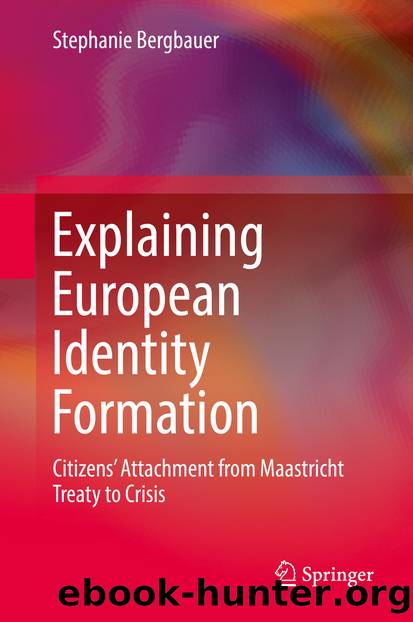Explaining European Identity Formation by Stephanie Bergbauer

Author:Stephanie Bergbauer
Language: eng
Format: epub
Publisher: Springer International Publishing, Cham
4.4.1 EU Enlargement to CEE and Citizens’ Identification with Europe
As regards developments in European identification in the context of EU enlargement to Central and Eastern Europe, we observe only minor fluctuations in the EU aggregate in response to the 2004/2007 accession rounds. The share of respondents describing themselves (also) as European (self-categorisation as European) decreases slightly: standing at 59% in 2002 (2 years before enlargement), it falls to 55% in 2007 when Bulgaria and Romania accessed the EU (cf. Fig. 4.1). Attachment to Europe, on the other hand, temporally peaks in the immediate aftermath of enlargement 2004 (cf. Fig. 4.5). The proportion of respondents feeling fairly or very attached to Europe increases from around 60% in autumn 2003 to about 69% in autumn 2004 and drops back to 64% in spring 2006. The temporal increase suggests a positive effect of enlargement on citizens’ attachment to Europe, but also is part of a longer upward trend in European attachment starting in the 1990s. A similar increase is visible in citizens’ attachment to the EU in the 2000s, starting from a relatively low 42% in early 2002 to 52% in spring 2006 and 55% in spring 2007. European pride, finally, does not fluctuate much during the accession period, either (cf. Fig. 4.3). The proportion of respondents’ indicating to be fairly or very proud to be European raises temporarily from 68% in autumn 2003 to 72% in autumn 2004, but falls back to 69% in autumn 2005.
Overall, enlargement appears to have caused only minor changes in European identification in the EU population as a whole, but there may be differences between the so-called ‘old’ member states (EU6, EU15) and the ‘new’ member states from Central and Eastern Europe. For example, we may expect identification with Europe to be stronger in the old member states because citizens in these countries have had more time to become accustomed to the European Union and experience European integration. Such socialisation effects should lead to higher levels of European identification in the EU15 member states than in the CEE countries (and higher levels of identification in the six EU founding countries than the rest of the EU member states). On the other hand, we may expect ‘salience effects’ in the CEE countries whereby the prominent role that the EU played in these countries during the accession period leads to higher levels of identification in the aftermath of enlargement.
The trends in European identification by country group only partly confirm these expectations.
Figures 4.7, 4.8, and 4.9 compare levels of self-categorisation as European and attachment to Europe/the EU in the EU6, the EU15, the CEE member states, and the EU aggregate.
Fig. 4.7Self-Categorisation as European in Groups of EU Member States 1992–2013
Download
This site does not store any files on its server. We only index and link to content provided by other sites. Please contact the content providers to delete copyright contents if any and email us, we'll remove relevant links or contents immediately.
50 Economics Classics by Tom Butler-Bowdon(2063)
Six Billion Shoppers by Porter Erisman(1996)
Why Nations Fail: The Origins of Power, Prosperity, and Poverty by Daron Acemoglu & James Robinson(1784)
No Time to Say Goodbye(1755)
The Economist [T6, 22 Thg9 2017] by The Economist(1641)
Red Notice by Bill Browder(1587)
Currency Trading For Dummies by Brian Dolan(1543)
Thank You for Being Late by Thomas L. Friedman(1451)
Bitcoin: The Ultimate Guide to the World of Bitcoin, Bitcoin Mining, Bitcoin Investing, Blockchain Technology, Cryptocurrency (2nd Edition) by Ikuya Takashima(1415)
Amazon FBA: Amazon FBA Blackbook: Everything You Need To Know to Start Your Amazon Business Empire (Amazon Empire, FBA Mastery) by John Fisher(1299)
The Great Economists by Linda Yueh(1181)
Coffee: From Bean to Barista by Robert W. Thurston(1178)
The Future Is Asian by Parag Khanna(1169)
Pocket World in Figures 2018 by The Economist(1150)
Capitalism Without Capital: The Rise of the Intangible Economy by Jonathan Haskel(1122)
Grave New World by Stephen D. King(1107)
How Money Got Free: Bitcoin and the Fight for the Future of Finance by Brian Patrick Eha(1095)
The Sex Business by Economist(1083)
Cultural Intelligence by David C. Thomas(1009)
